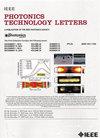弱微扰下的高q偏振无关双bic超表面
IF 2.5
3区 工程技术
Q2 ENGINEERING, ELECTRICAL & ELECTRONIC
引用次数: 0
摘要
具有超高品质因子(Q)的连续介质准束缚态(BIC)对于促进光子器件的发展具有重要意义。然而,引入小尺寸不对称或微扰的设计策略对其实际实现提出了很大的挑战。在这里,我们提出了一个具有相对大扰动参数的完全对称超表面,支持由布里渊区折叠(BZF)引起的两个高q准bics,可以避免微小的结构不对称或位置变化。BZF是通过周期性地将圆形纳米棒(即微扰)引入晶格的弱本特征场区域来触发的,即使圆形纳米棒的半径相对较大,也可以在$\Gamma $点处产生两个高q准bic。此外,单位电池的C4对称性保持不受干扰,使其对入射偏振不敏感。bic还表现出对晶格形状的不明显依赖,进一步提高了制造公差。数值模拟表明,即使圆形纳米棒的半径为60纳米,也可以获得高达16,390的超高Q值。这样的设计将有助于在光学传感和非线性等各种应用领域实现高性能光子器件。本文章由计算机程序翻译,如有差异,请以英文原文为准。
High-Q Polarization-Independent Dual-BIC Metasurface via Weak Perturbation
Quasi-bound state in the continuum (BIC) with ultra-high quality factor (Q) is of paramount significance for promoting the development of photonic devices. However, the design strategies of introducing small dimensional asymmetry or perturbation pose great challenge for its actual realization. Here, we propose a totally symmetric metasurface with relatively large perturbation parameters that supports two high-Q quasi-BICs induced by Brillouin zone folding (BZF), which can avoid tiny structural asymmetry or positional change. The BZF is triggered by periodically introducing circular nanorods (i.e., perturbations) into the weak eigenfield regions of the lattice, enabling two high-Q quasi-BICs at $\Gamma $ point even when the radius of the circular nanorods is relatively large. Moreover, the C4 symmetry of the unit cell remains undisturbed, making it insensitive to the incident polarization. The BICs also exhibit inconspicuous dependence on the shape of the lattice, further enhancing the manufacturing tolerances. Numerical simulations show that an ultra-high Q of up to 16,390 can be accessible even when the circular nanorods has a 60-nm radius. Such design will help facilitate the implementation of high-performance photonic devices in a variety of application fields such as optical sensing and nonlinearity.
求助全文
通过发布文献求助,成功后即可免费获取论文全文。
去求助
来源期刊

IEEE Photonics Technology Letters
工程技术-工程:电子与电气
CiteScore
5.00
自引率
3.80%
发文量
404
审稿时长
2.0 months
期刊介绍:
IEEE Photonics Technology Letters addresses all aspects of the IEEE Photonics Society Constitutional Field of Interest with emphasis on photonic/lightwave components and applications, laser physics and systems and laser/electro-optics technology. Examples of subject areas for the above areas of concentration are integrated optic and optoelectronic devices, high-power laser arrays (e.g. diode, CO2), free electron lasers, solid, state lasers, laser materials'' interactions and femtosecond laser techniques. The letters journal publishes engineering, applied physics and physics oriented papers. Emphasis is on rapid publication of timely manuscripts. A goal is to provide a focal point of quality engineering-oriented papers in the electro-optics field not found in other rapid-publication journals.
 求助内容:
求助内容: 应助结果提醒方式:
应助结果提醒方式:


